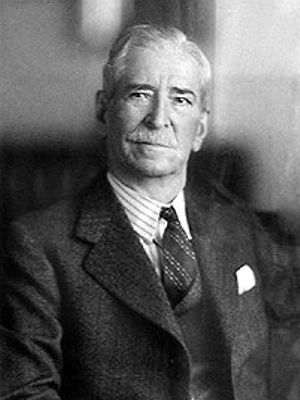
Secretary of the Navy Claude A. Swanson.
Born at Swansonville in Pittsylvania County, Virginia on 31 March 1862, he was graduated from Randolph-Macon College in June 1885 and earned a law degree from The University of Virginia in July 1886.
In 1892, he was elected to the United States House of Representatives, in which he served seven terms beginning in 1893.
In 1906, he was elected the 45th Governor of Virginia, and served one term. His tenure was marked by important improvements in Virginia’s educational, health and transportation systems: the number of high schools increased by more than five times and the number of teachers’ colleges from two to four; also, a State Health Department was organized and a Department of Transportation was established.
In 1910, Governor Swanson was appointed to an unexpired US Senate seat, to which he was later elected and re-elected until his appointment as Secretary of the Navy in 1933. During his time in the Senate, he served on the Naval Affairs and Foreign Relations Committees. In 1932, President Herbert Hoover appointed Senator Swanson to the General Disarmament Conference in Geneva, Switzerland—the only Congressional member of the United States Delegation.
When Franklin D. Roosevelt was elected president, he appointed Senator Swanson as Secretary of the Navy, effective in March 1933. Secretary Swanson’s congressional experience in naval affairs and his outspoken support of a strong navy immediately paid off—making him one of the greatest peacetime naval fleet builders in American history.
Secretary Swanson lived most of his life at his estate Eldon in Pittsylvania County, Virginia. He died in office on 7 July 1939 and was buried in the Hollywood Cemetery, Richmond, Virginia.
Sources: Historic Hampshire and Dictionary of American Naval Fighting Ships.